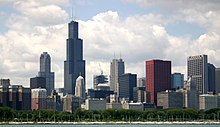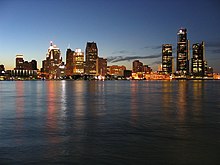Middle West
The Midwest ( English the Midwest ) is a region of the United States . The name arose in the 19th century from the need to distance oneself from the east coast , hence “west” - but not as far to the west as the frontier at that time ( wild west ).
Demarcation
The delimitation of the Midwest is not precisely defined. According to the classification of the U.S. Census Bureau based on statistical purposes , the following states belong to the region, which is again divided into an eastern and a western part:
- West North Central Division
- North Dakota , South Dakota , Nebraska , Kansas
- Minnesota , Iowa , Missouri
- East North Central Division
North Dakota, South Dakota, Nebraska and Kansas are included in the Midwest in particular if the “ Great Plains ” region is not included in the categorization . Mostly Missouri , and occasionally Kentucky, is considered a state of the Midwest, but the latter in particular is sometimes counted among the southern states . (They weren't part of the Confederate States of America , but they allowed slavery until the Civil War .)
Pennsylvania is also rarely considered part of the Midwest because the state has no coast to the Atlantic Ocean and a part is also west of the Appalachians . This classification is halfway understandable for the area around Pittsburgh and Erie , but not for the state as a whole, since the eastern half around Philadelphia has little in common historically and geographically with the Midwest. The same applies to the westernmost part of Upstate New York .
A definition can be derived from survey data according to which the Midwest primarily consists of nine states: In a survey carried out in 2014 among 1,357 people who describe themselves as Midwesterner , it was found that 70 of these states Indiana , Iowa and Illinois % and more, Michigan , Wisconsin and Minnesota to 60% and more and Ohio , Missouri and Kansas to over 50% belong to the Midwest.
The largest survey to date, with over 12,000 respondents in 2019, confirmed the principles, but in both Kansas and Nebraska there are only a small minority who assign their region to the Midwest. In some states there is a clear majority of people who only consider part of the state to belong to the Midwest. In South Dakota, the agricultural east is assigned to the Midwest, the west of the state, in which ranching, mining and tourism determine the economy, would then not be part of the region.
Geography and economics
The area of the Midwest is largely shaped by the glacier advances of various Ice Ages ( Laurentide Ice Sheet ). Especially in Michigan, Wisconsin and Minnesota many lakes were created and the terrain is mostly flat in Illinois and northern Indiana as well as in Ohio. To the south and west, where the glacier times are a long time ago, the landscape becomes slightly hilly due to erosion up to the valleys of the Ohio and Mississippi Rivers as well as the Shawnee Hills , the Ozark Mountains and the Badlands of South Dakota. Due to the glacier periods, the soils in this region are very fertile. If the climate allows sufficient growth time, agriculture (grain, maize, livestock farming) is practiced very intensively in this region . The Midwest is therefore known as the “ bread basket of the nation ”. The northern area of Minnesota, Wisconsin and Michigan is more dominated by forestry due to the long winters.
The big cities in the region are industrial . The region around the "car city" Detroit, which is still part of the Rust Belt , the traditional focus of American heavy industry, as well as the supplier industry (steel, tires) around Cleveland, must be mentioned here. These cities were badly affected by industrial structural change and are therefore struggling with unemployment and social problems. The Chicago metropolitan area has a broader economic base - in addition to the steel industry in the southern part of the city (around Lake Calumet ) and along the Calumet River (e.g. Gary ), many large companies have their headquarters in the city and with the Chicago Board of trade is an important place in the financial sector. Chicago is also an important hub for road, rail and air traffic. Smaller towns like Decatur or Battle Creek also contribute to the industrial character of the region.
Largest cities (as of 2014)


-
Chicago , Illinois, 2,722,000
-
Indianapolis , Indiana, 849,999
-
Columbus , Ohio, 836,000
-
Detroit , Michigan, 680,000
-
Milwaukee , Wisconsin, 600,000
-
Kansas City , Missouri, 471,000
-
Omaha , Nebraska, 447,000
-
Minneapolis , Minnesota, 407,000
-
Cleveland , Ohio, 390,000
-
Wichita , Kansas, 388,000
-
St. Louis , Missouri, 307,000
-
Cincinnati , Ohio, 298,000
-
Saint Paul , Minnesota, 298,000
-
Toledo , Ohio, 298,000
-
Lincoln , Nebraska, 273,000
population
In the 19th century, the Midwest had a very high density of German-speaking residents , in many regions they made up the majority. The cities of St. Louis, Milwaukee and Omaha in particular were centers of German culture, which can still be seen in the large number of breweries there. Even today, most of the German-Americans can be found there , but in terms of origin, not language. About a fifth of the total population in the United States reported being German-American at the last census in 2000 , most of them in the Midwest. Immigrants from Scandinavia and their descendants also live in the Midwest, especially in the region around the Great Lakes.
Between 1910 and 1930, many African-Americans from the southern states immigrated to the industrial cities of the Midwest in the course of the Great Migration ; In the country, however, unlike in the southern states, there are hardly any Afro-American residents.
Chicago was and is a frequent destination for immigrants . This is how many Poles live in Chicago today . Latin American naturalized immigrants make up the majority of the 4th Congressional District in the southwest of the city, Albany Park District operates two Korean-language newspapers, and there is a Korean-language television station.
Social and political character
The Midwest is popularly said to be particularly down-to-earth (for example, the question “ Will it play in Peoria ?”). However, it would be wrong to imagine a uniform conservatism here . The Midwest also includes union strongholds such as the industrial cities of Detroit and Cleveland and liberal university cities such as Ann Arbor , Urbana , Bloomington and Madison .
Because of this diversity, the states of the Midwest have also been the origin of very different political movements from the early 19th century, which gained influence throughout the United States.
- The abolitionists , the opponents of slavery, were among the first . Abraham Lincoln, for example, came from this milieu .
- Around 1900 the populist movement around William Jennings Bryan flourished, especially in the agrarian part of the region west of Chicago .
- Wisconsin was a stronghold of the progressive reform movement of the early 20th century, which was mainly led by Robert M. La Follette sr. was carried. At the same time, the Indiana native Eugene V. Debs was one of the defining figures of the socialist labor movement .
- In the interwar period , the Midwest was a stronghold of the isolationist movement . The numerous Americans of German and Swedish origin were influential here .
- Many progressive reforms began in the Midwest. Michigan abolished the death penalty as early as the 19th century. Illinois was the first US state to abolish sodomy legislation .
- Recently, politicians like Richard Gephardt , John Conyers , Dennis Kucinich , Hillary Clinton and Barack Obama have come from the Midwest.
- Overall, the political formation is very different to this day.
Traditionally, Missouri in particular and, more recently, Ohio have been assigned the role of a swing state that is decisive for the election , because their population structure represents that of the entire United States and therefore reflects political trends well. In the 2004 presidential election , eight out of twelve states in the Midwest voted with a majority for Republican incumbent George W. Bush , seven in 2008 and six out of twelve for Democrat Barack Obama in 2012 . In 2016 , Republican Donald Trump surprisingly won in every state in the Midwest with the exception of Illinois and Minnesota, which was seen as crucial to his electoral success.
literature
- Jürgen Scheunemann: USA. East Coast, Midwest, Southern States. A current travel guide with 146 illustrations and 24 map excerpts. Nelles, Munich 2001, ISBN 3-886-18354-8 . 255 pp.
- JR Shortridge (1985): The Vernacular Middle West . In: Annals of the Association of American Geographers , 75, pp. 48-57.
- Detailed presentation of the Shortridge study on the development of spatial image structures (“Where is the Midwest actually?”) And presentation by Mental Maps , in: Peter Weichhart : Development Lines of Social Geography. From Hans Bobek to Benno Werlen. Franz Steiner Verlag, Stuttgart 2008, ISBN 3-515-08798-2 . Pp. 198-202.
- Richard Sisson, Andrew Cayton, Chris Zacher: The American Midwest: An Interpretive Encyclopedia , Indiana University Press, 2007. ISBN 0-253-34886-2 .
- Andrew Cayton, Susan E. Gray (Eds.): The Identity of the American Midwest: Essays on Regional History , Indiana University Press, 2007. ISBN 0-253-21920-5 .
- Robert Wuthnow: Remaking the Heartland: Middle America since the 1950s , Princeton University Press, 2010. ISBN 0-691-14611-X .
- Manfred Zirkel: Man and Myth. The Midwest in Wright Morris' novels . Bouvier, Bonn 1977, 309 pp. ISBN 3-416-01339-5 .
Web links
Individual evidence
- ↑ http://fivethirtyeight.com/datalab/what-states-are-in-the-midwest/
- ↑ David Montgomery: We Mapped 'the Midwest' for You, So Stop Arguing Citylab, August 29, 2019


